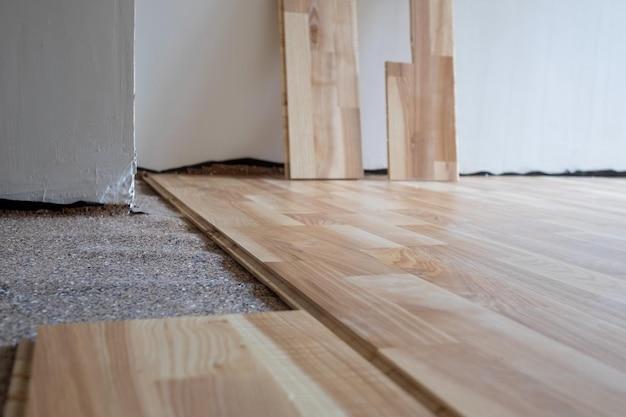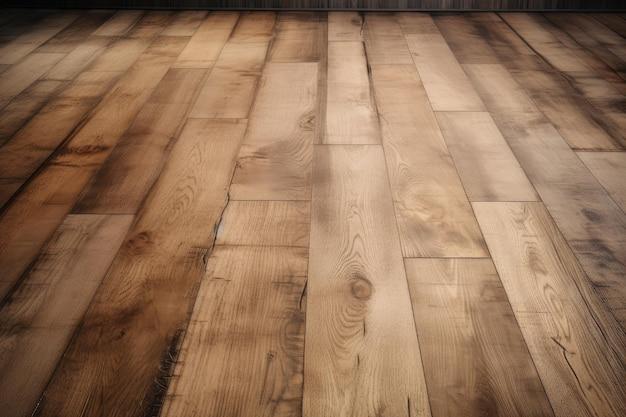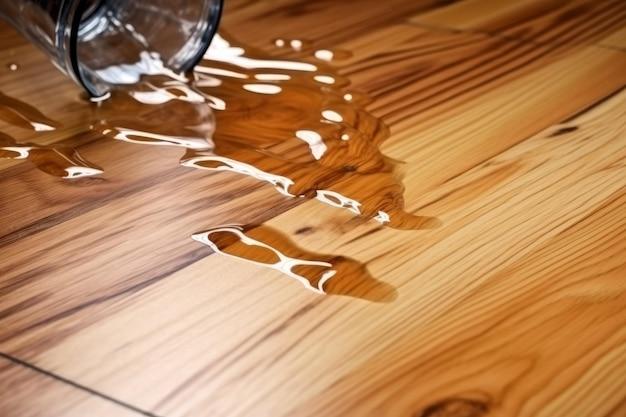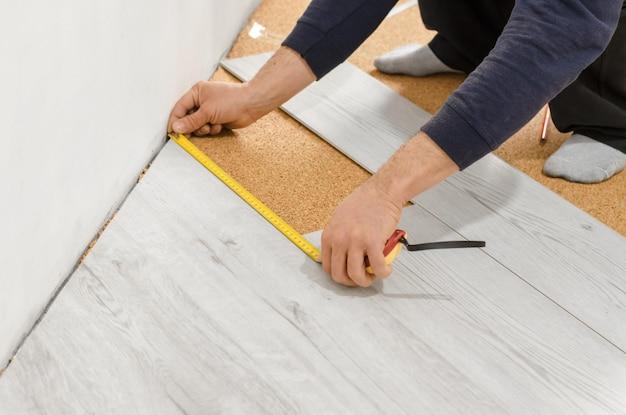Vinyl plank flooring is a popular flooring option for basements due to its water-resistant properties. However, even with the best intentions, accidents happen, and water can end up seeping under vinyl floors, especially in basements. The question is, what happens when water gets under vinyl plank flooring in the basement?
Will the water evaporate naturally? Can mold grow under vinyl plank flooring? Is it necessary to install a moisture barrier under vinyl plank flooring on concrete? These are some of the questions that we’ll answer in this comprehensive guide.
If you find yourself in a situation where there’s water under your vinyl plank flooring in the basement, don’t worry; you’re not alone. Many homeowners have faced this problem, and it can be daunting to handle. But fear not, we’re going to walk you through everything you need to know to deal with water under vinyl plank flooring in the basement.
In this blog post, we’ll address the following concerns: how to get water out from under flooring, what to put under vinyl plank flooring in the basement, what happens if water gets under Lifeproof flooring, and whether or not mold can grow under vinyl plank flooring.
So, let’s dive in and explore the world of water under vinyl plank flooring in basements.
Water Under Vinyl Plank Flooring in Basement: Causes and Solutions
Vinyl plank flooring is a popular choice for homeowners looking for an affordable, durable, and easy-to-install flooring option. However, water damage is a common problem that many homeowners face when it comes to vinyl plank flooring, especially in basements.
Causes of Water Under Vinyl Plank Flooring in Basement
Water can seep through cracks and gaps in the basement walls and foundation, leading to moisture buildup and mold growth. Other common causes of water damage under vinyl plank flooring include leaky pipes, faulty plumbing, floods, and heavy rainfall.
Signs of Water Under Vinyl Plank Flooring in Basement
One of the first signs of water damage under vinyl plank flooring is a soft, spongy feel underfoot. You may also notice warping, cupping, or buckling of the flooring. A musty smell and dampness are other indications of water damage.
Solutions to Water Under Vinyl Plank Flooring in Basement
If you suspect that there is water damage under your vinyl plank flooring, you should act quickly to prevent further damage. Here are some solutions to consider:
-
Identify and fix the source of the water problem, such as repairing leaky pipes or installing a sump pump.
-
Remove damaged vinyl planks and dry out the affected area using a dehumidifier or fan.
-
Seal basement walls and foundation with waterproof coatings to prevent moisture buildup.
-
Install a subflooring system with a moisture barrier that prevents water from seeping through the subfloor and into the vinyl planks.
In conclusion, water under vinyl plank flooring in the basement can cause significant damage to your flooring and home. However, by identifying the causes of water damage, looking out for signs of damage, and taking immediate action to rectify the situation, you can protect your home and prolong the life of your vinyl plank flooring.
Water Under Vinyl Flooring Concrete
One of the most frustrating issues homeowners face with their home is when water seeps under their vinyl flooring. When it comes to a basement or any other area where water is more prevalent, water under your vinyl can be a significant concern. Here are some tips to help you navigate this challenging situation:
Causes of Water Under Vinyl Flooring
Water can seep under your vinyl flooring due to several reasons, such as high humidity levels or poorly sealed concrete. The most common cause of water under vinyl flooring is moisture in the concrete beneath it. If you have concrete flooring, you need to verify that it’s not absorbing moisture from the ground. Additionally, any cracks in the concrete floor or walls allow water to seep in, leading to water buildup and, subsequently, damage to your flooring.
How to Detect Water Under Vinyl Flooring
Detecting water under your vinyl flooring can be challenging, but there are some warning signs to keep in mind. The first sign that there may be water under your vinyl flooring is bubbling and heaving. Additionally, if the area smells musty or has a “wet” scent, it’s possible that water has seeped under the vinyl.
How to Fix Water Under Vinyl Flooring
Dealing with water under your vinyl flooring can be a hassle, but there are several ways to address the issue. If water has only seeped under one section of your vinyl flooring, you may be able to fix the problem by merely removing the affected area and drying it out. However, if the problem is widespread, you may need to install a drainage system to address the moisture buildup and prevent it from happening again.
Prevention is Key
As with any home-related issue, prevention is the best cure. To prevent water from seeping under your vinyl flooring, make sure your home’s exterior drainage is working correctly. Additionally, you should keep your home’s interior humidity levels at a reasonable level to avoid excess moisture in the concrete.
In conclusion, water under vinyl flooring concrete can be a major headache for homeowners. By understanding the causes, detecting early warning signs, and taking proactive measures, you can prevent water from seeping under your vinyl flooring and protect your home.
Will Water Under Vinyl Floor Dry Out
Vinyl flooring is known for its durability, affordability, and versatile design options. It’s no surprise that more and more homeowners are opting for vinyl flooring to outfit their basements. But what happens if water seeps under your vinyl flooring?
The Short Answer: Maybe
The short answer to this question is that it depends on the amount of water and how long it’s been there. If you’ve only had a minor spill or if you’ve caught the water damage early, your vinyl floor may dry out on its own. However, if you have a significant leak or have left the water for an extended period, there’s a good chance that your floor won’t dry out without intervention.
How Can You Tell if the Water Has Dried Out
It can be challenging to tell if water has dried out under your vinyl flooring, but keep an eye out for the following signs:
- Cupping or buckling of the vinyl planks
- Discoloration or staining of the flooring
- A musty or moldy smell
- Warping of the subfloor
If you notice any of these signs, it’s best to assume that the water has not dried out and take action to remedy the situation.
What to Do if Your Vinyl Floor Has Water Damage
If you suspect that your vinyl flooring has water damage, it’s essential to act quickly to prevent further damage. Here are a few steps you can take:
- Remove any standing water or moisture from the area.
- Use fans or a dehumidifier to dry out the affected area.
- Check the subfloor for any damage or warping.
- Call a professional if you’re uncertain about the extent of the damage.
Preventing Water Damage to Your Vinyl Floor
Prevention is always better than a cure, and there are steps that you can take to prevent water damage to your vinyl floor. Here are a few tips:
- Use a moisture barrier under your vinyl flooring.
- Choose waterproof vinyl flooring options.
- Regularly check for leaks or moisture in your basement.
- Address any water damage promptly.
In conclusion, if water has seeped under your vinyl flooring, there’s a chance that it will dry out on its own. However, it’s essential to keep an eye out for signs of damage and take swift action if necessary. By taking steps to prevent water damage in the first place, you can ensure that your vinyl flooring lasts for years to come.
How to Get Water Out from Under Flooring
Vinyl plank flooring is a great addition to any basement, but it’s essential to make sure that there’s no water underneath it. Water can get under flooring due to plumbing leaks, heavy rainfall, or basement floods. Whatever the reason, it’s crucial to get it out as soon as possible to avoid causing any further damage. Here are some steps to get the water out from under the flooring:
Identify the Source of the Water
Before you can start the process of removing the water, you need to figure out where it’s coming from. This is especially important if you have recurring issues with water seeping under your vinyl plank flooring. Check for any visible water leaks or damage to pipes, and repair them before removing the water to prevent further flooding.
Remove the Excess Water
The next step is to remove as much of the excess water as possible. You can use a wet-dry vacuum to suction the water out from under the flooring. Make sure to use a vacuum designed for wet surfaces. If you don’t have a wet-dry vacuum, you can use towels or a mop to soak up the standing water.
Dry the Area
After removing the water, the next step is to dry the affected area. You can use a dehumidifier to reduce the moisture levels in the air. Make sure to open windows and doors to improve ventilation. You can also use fans to increase air circulation and help dry the area faster. Don’t forget to remove any wet or damaged materials like carpets or rugs.
Sanitize the Area
Once the area is dry, you need to sanitize it to prevent any mold or bacterial growth. For this, you can use a solution containing one part bleach to ten parts water. Wipe the affected area with the solution and let it dry completely. Wear gloves to protect your skin and avoid any contact with the bleaching solution.
Check for Additional Damage
Finally, it’s essential to check for any additional damage like warping or cracking of the vinyl plank flooring. If there’s any damage, you need to repair or replace the affected flooring to avoid further issues.
In conclusion, getting water out from under your vinyl plank flooring is crucial to prevent further damage to your basement. Remember to identify the source of the water, remove the excess water, dry the affected area, sanitize it, and check for any additional damage to your flooring. By following these steps, you’ll be able to keep your basement in excellent condition and enjoy your vinyl plank flooring for years to come.
Can Mold Grow Under Vinyl Plank Flooring
Vinyl plank flooring (VPF) is a popular choice for many homeowners due to its durability and water resistance. However, concerns about mold growth under VPF in basements may arise.
Understanding Mold Growth
Mold growth occurs when there is moisture and a food source for the mold. Under the right conditions, mold can thrive within 24-48 hours. The presence of mold can lead to health problems, particularly for those with respiratory issues.
Causes of Mold Growth
Mold can grow under VPF in basements if there is moisture from water leaks, high humidity, or inadequate ventilation. Mold can also grow under VPF if the flooring was installed over a damp surface.
Prevention Measures
To prevent mold growth under VPF, it is important to address any moisture issues promptly. Fix water leaks immediately, use a dehumidifier to maintain humidity levels below 60%, and ensure proper ventilation in the basement.
Another prevention measure is to choose VPF with an attached underlayment that has antimicrobial properties. The antimicrobial properties discourage the growth and spread of molds, mildew, and bacteria, keeping your floors clean and fresh.
While mold growth under VPF in basements is a concern, it can be prevented by addressing moisture issues promptly and choosing VPF with antimicrobial underlayment. With proper installation and maintenance, VPF can offer a durable and water-resistant flooring solution for your basement.
What to Put Under Vinyl Plank Flooring in Basement
If you’re planning to install Vinyl Plank Flooring in your basement, you’re likely wondering what to put under the flooring to minimize any water damage and ensure your flooring lasts as long as it should. Here’s a rundown of what you need to consider.
Moisture Barrier
Water is the enemy of Vinyl Plank Flooring. Even small amounts of moisture can cause the planks to warp, bubble, or peel. Therefore, it is crucial to install a moisture barrier before laying the flooring. There are several options to choose from, including:
- Plastic sheathing
- Concrete sealer
- Moisture blocking underlayment
Ask your flooring supplier what types of moisture barriers they have in stock, as they will have a better idea of which is suitable for your region’s climate and moisture conditions.
Underlayment
It is vital to use an underlayment under your Vinyl Plank Flooring to provide cushioning and noise reduction, and to help your floors stand the test of time. When choosing an underlayment, it’s crucial to consider the following:
- The purpose of the room: A room with heavy foot traffic will benefit from a denser underlayment than a less heavily frequented room.
- The subfloor type: Cement floors may require a different underlayment than wood subfloors.
- Sound-blocking qualities: If you want to dampen sounds, look for an underlayment with noise-reducing properties.
Foam Padding
If you want to maximize cushioning and wearability, consider installing Foam Padding under your underlayment. Although this extra layer will cost you a little more money, it is worth the investment. Foam padding can prevent unsightly marks on your floors, make them more enjoyable to walk on, and help with sound analysis.
Before installing Vinyl Plank Flooring in your basement, ensure you take the time to research the best underlayment and moisture barriers for your specific needs. By following the correct installation procedures, you can have a sturdy and long-lasting floor that is both durable and beautiful, even in the most challenging outdoor conditions.
What Happens If Water Gets Under Lifeproof Flooring
Lifeproof flooring is a popular choice for homeowners, thanks to its durability and waterproof properties. It can withstand spills, splashes, and even floods. However, if water gets under your lifeproof flooring, it can cause serious damage, and you need to act quickly.
Signs Water Has Entered Your Lifeproof Flooring
The first thing you might notice is discoloration or warping in your flooring. If you see water pooling or signs of moisture around the edges or corners, that’s a strong indicator that water has seeped underneath. You might even hear a squishing or tapping sound when you walk across the flooring.
What Happens If You Ignore It
Now, here’s the thing: if you don’t address the issue immediately, the water can wreak havoc on your flooring. It can lead to mold growth, which can cause health problems. It can also weaken the structural integrity of your flooring, making it more susceptible to further damage. Worst case scenario, you might have to rip out the entire flooring and start from scratch.
What To Do If Water Gets Under Your Lifeproof Flooring
The very first thing you need to do is identify the source of the water and fix it. It might be a leaky pipe, a crack in the foundation, or poor drainage in your basement. Once you’ve addressed the underlying problem, it’s time to tackle the water in your flooring.
Use a wet/dry vacuum or towels to soak up as much of the water as possible. Then, use fans and dehumidifiers to dry out the area thoroughly. If there are any signs of mold growth, you’ll need to call in experts to take care of it.
Preventing Water Damage
The best way to deal with water under your lifeproof flooring is to prevent it from happening in the first place. Make sure your basement is properly sealed, and address any drainage issues you may have. If you live in a flood-prone area, consider investing in a sump pump or other flood prevention measures.
In conclusion, water under lifeproof flooring can cause serious damage if left unaddressed. Keep an eye out for signs of moisture, and act fast if you notice any. With proper maintenance and prevention, you can keep your lifeproof flooring looking great for years to come.
What Happens If You Get Water Under Vinyl Plank Flooring
If you’ve recently installed vinyl plank flooring in your basement, you know how water-resistant this flooring can be. However, accidents happen, and water can sometimes find its way underneath the flooring.
Importance of Addressing Water Under Vinyl Plank Flooring
If you discover water under your vinyl plank flooring, it’s crucial to address it as quickly as possible. Water can easily seep into the grooves between the planks, causing warping, swelling, and other types of damage. The longer you wait to take action, the higher the risk of permanent damage to the flooring.
Signs of Water Damage
One of the first signs that you have water under your vinyl plank flooring is buckling. The flooring will start to lift and separate from each other, creating unattractive gaps. As the water damage gets worse, you may notice a musty smell or even mold growing underneath the planks.
How to Fix Water Under Vinyl Plank Flooring
Before attempting a DIY fix, you should first determine the extent of the water damage. If the damage is extensive, it’s best to seek the help of a professional. For minor damage, start by removing the planks that are most affected by the water. Dry the subfloor using a dehumidifier or a fan and replace the damaged planks.
Preventing Future Water Damage
To prevent water from seeping under your vinyl plank flooring in the future, you can get a moisture barrier installed. A moisture barrier will help prevent moisture from the concrete subfloor from coming up and seeping into your flooring. You can also consider waterproofing your basement walls to prevent moisture from seeping in.
Don’t underestimate the power of water damage when it comes to your vinyl plank flooring. Take action as soon as you notice any signs of water damage to prevent further problems.
Do You Need a Moisture Barrier Under Vinyl Plank Flooring on Concrete
Vinyl plank flooring is a popular flooring choice, especially in basements, due to its durability, water resistance, and affordability. But, there’s a catch; you need to ensure it’s installed correctly and with the appropriate materials to avoid water damage and costly repairs.
One of the common questions people ask is whether a moisture barrier is necessary under vinyl plank flooring on concrete. The answer is YES.
Why Do You Need a Moisture Barrier
Concrete floors have a tendency to hold moisture, and if you install vinyl plank flooring directly on the concrete floor without a moisture barrier, the moisture can seep through and damage your flooring. The damage can range from mildew and mold growth to popping and buckling of the planks, leading to costly repairs.
Types of Moisture Barriers
The good news is that many types of moisture barriers are available, including:
-
Polyethylene Plastic Sheeting: This is a cheap and easy-to-install moisture barrier that is effective at reducing moisture transfer. However, it’s not suitable for long-term use and may tear easily during installation.
-
Asphalt Felt Paper: This moisture barrier is commonly used with hardwood flooring, but it’s also suitable for vinyl plank flooring. It’s a breathable material that allows airflow and helps reduce moisture buildup.
-
Rubber Membrane: This is a premium moisture barrier that is durable, long-lasting, and resistant to tearing and punctures. It’s the best option for high-moisture areas.
Moisture Testing
Before installing a moisture barrier or your vinyl plank flooring, it’s essential to test the moisture levels using a moisture meter. This test will help you determine whether you need a moisture barrier and which type will work best for your situation.
In conclusion, installing a moisture barrier under vinyl plank flooring on concrete is a crucial step to prevent water damage and extend the lifespan of your flooring. When installing the moisture barrier, ensure that you follow the manufacturer’s instructions to avoid costly mistakes.



